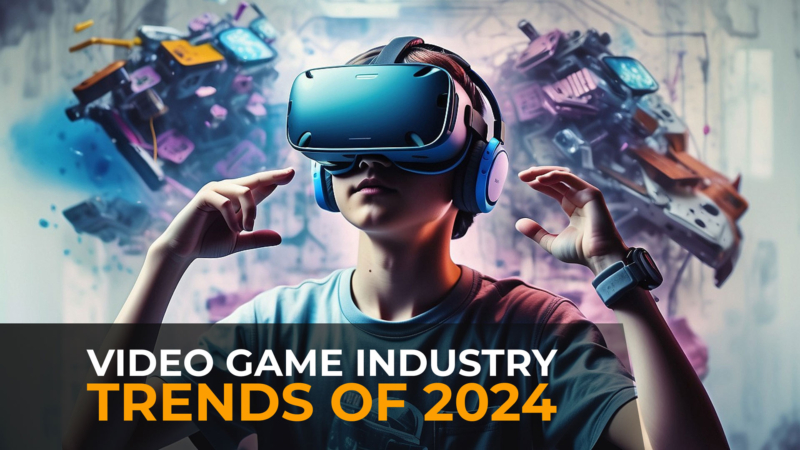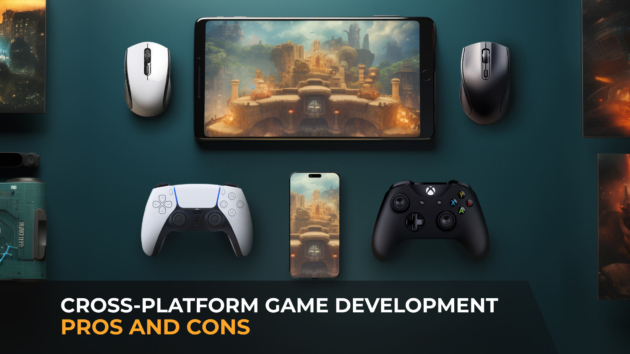Staying ahead of gaming industry trends isn’t just a matter of curiosity – it’s a strategic imperative for game publishers. As the landscape evolves rapidly, understanding emerging patterns and player preferences can mean the difference between success and obscurity.
As a seasoned game development vendor, Stepico consistently strives to keep our finger on the pulse of industry shifts, ensuring we remain at the forefront of innovation and deliver experiences that resonate with modern gamers. In this article, our experts will share some of the most prominent game development trends of 2024.
Video Game Industry Trend #1: Cross-platform development
One of the hottest trends of 2024 is the industry’s growing focus on cross-platform game development. This approach allows titles to be released across different platforms like PCs, consoles, and mobile phones, which helps publishers reach a wider audience and maximize player engagement.
Our experience with clients indicates that this trend is one of the fastest-growing, as it has enabled many of them to successfully target a broader player base. However, publishers must also recognize that fully leveraging it requires a solid grasp of the unique challenges and opportunities it presents, as well as the necessary expertise. Here are some of the best practices we follow at Stepico to ensure a seamless and successful cross-platform development process:
- Planning for multiple platforms. We start by carefully considering the target platforms, their specific strengths and limitations, and how the gameplay experience will translate across each one.
- Choosing the right tools. We leverage powerful game engines like Unity or Unreal Engine that offer robust cross-platform development capabilities, allowing for a significant amount of code reuse and streamlining the process.
- Prioritizing consistent UX. While catering to each platform’s strengths, we ensure a core gameplay experience that feels consistent and enjoyable for players regardless of their device. This includes aspects like unique UI/UX design, controls, and overall performance optimization.
- Rigorous testing. Extensive testing across all target platforms is crucial to identify and address any compatibility issues or performance bottlenecks before launch.
Trend #2: AR and XR as the Future of the Gaming Industry
As Apple Vision Pro, Meta Quest 3, and similar devices have become available and gathered considerable buzz, it’s very likely that in 2024 game publishers will try to leverage the transformative potential of AR and XR in their titles. These devices open the doors for:
- Location-based gaming, which can transform everyday spaces into interactive playgrounds. Games like Pokemon Go popularized this concept a while ago, but today’s devices can bring this type of gaming to a completely different level, offering seamless and integrated experience.
- Interactive Storytelling. AR can weave narratives into real-world environments. This means historical landmarks can come alive with virtual characters and events. AR glasses, which have features like object recognition, could further enhance these interactive experiences, providing publishers a plethora of opportunities for creating thematic and engaging titles.
Challenges of AR Game Development
- Technical limitations. Current AR technology still faces limitations in terms of processing power, battery life, and accurate object categorization.
- Monetization strategies. Working on an AR project requires careful consideration of monetization strategies that don’t disrupt the gameplay or feel intrusive. Subscription models or in-game purchases that unlock additional AR content could be potential solutions.
XR encompasses both AR and VR. XR headsets can project not just visuals but also sound and haptic feedback. This is why they can be used for immersive world building. XR can help create expansive, interactive worlds that players can explore freely. This means, for example, that publishers can give players a chance to scale mountains in a virtual national park, collaborate on architectural projects in shared virtual spaces, experience historical events in a way that transcends traditional media, and much more.
Challenges of XR Game Development
- Hardware costs. High-end XR headsets can be expensive, limiting accessibility for a broader audience.
- Motion sickness. Some players may feel motion sickness in VR environments, which needs to be addressed through careful game design and user comfort considerations, especially when developing AR glasses with potentially wider fields of view.
While XR isn’t necessarily a mature technology yet, publishers who can expertly leverage its strengths, challenges, and potential right now can build a substantial competitive advantage for themselves, offering unique and innovative experiences that blur the lines between reality and the virtual world.
Video Gaming Industry Trend #3: Generative AI
The video game industry thrives on captivating visuals. GenAI is slowly but surely revolutionizing game art creation. Here’s why the trend is becoming ever-more important.
Boosting efficiency. AI can quickly produce a wide array of concept art variations, saving time and resources.
Inspiration spark. It can also help overcome creative roadblocks. AI can generate unexpected ideas to inspire artists and push the boundaries of visual storytelling.
Speeding up prototyping. In the early stages of game development, AI-generated concepts can help visualize ideas quickly for better decision-making.
Our company happens to have quite extensive expertise in leveraging GenAI tools for game creation. Our subbrand, Inkration, in particular, has been using these tools extensively to achieve high-impact outcomes. Here’s how exactly:
- Initial development stages. Inkration leverages GenAI at the beginning of the creative process, specifically for:
- Visual Research: AI helps gather reference images that inspire concept art.
- Concept Creation: AI assists in generating initial ideas and mood boards.
- Color Key Development: AI can propose color palettes to set the visual tone.
- Visual Research: AI helps gather reference images that inspire concept art.
That being said, we must stress that human touch remains crucial
- Inkration emphasizes that while AI aids in creating game art assets, human artists play an irreplaceable role in:
- Storytelling: Infusing the art with narrative and emotional depth to resonate with players.
- Artistic Vision: Adding a distinct style and personality that AI cannot achieve.
- Storytelling: Infusing the art with narrative and emotional depth to resonate with players.
The Synergy of Technology and Artistry
Our general approach is capitalizing on the value of combining cutting-edge AI tools with the talent and expertise of human artists. This blend allows us to produce:
- Unique Game Art: Artworks that stand out with their own character.
- Eye-Catching Visuals: Art that is visually captivating and engaging for players.
Examples of Inkration’s AI-powered Artworks:
AI Tools We Most Commonly Use for Game Art Creation
- Stable Diffusion (realistic, detailed images from text prompts and image edits)
- Midjourney (artistic creations based on text descriptions)
- DALL-E 3 (photorealistic images from text input, often used with ChatGPT prompts)
- Leonardo.AI (advanced generative AI with fine-tuned control over text-to-image generation)
Video Gaming Industry Trend #4: Independent App Stores
The mobile app market has been traditionaly dominated by giants like Google Play Store and Apple’s App Store. However, this year we are also seeing the rise of independent app stores trying to carve out their own niche. There are a few reasons behind this movement, and its potential impact can be profound.
Why are Independent App Stores Gaining Traction?
- Focus on specific needs. Independent app stores often cater to specific demographics, regions, or app categories. This allows for targeted curation and distribution of apps that might get overlooked in the vast landscape of major stores.
- Less restrictive policies. Some publishers feel stifled by the strict regulations and revenue sharing models of major app stores. Independent stores may offer more relaxed policies or fairer revenue splits, attracting developers seeking more control.
- Innovation and experimentation. Independent stores can be more open to innovative app ideas or those that might not fit the mainstream mold. This fosters creativity and experimentation within the app development landscape.
Examples of Independent App Stores
- Itch.io. Caters to indie game developers, offering a platform for niche and experimental games.
- Samsung Galaxy Store. Pre-installed on Samsung devices, it offers a curated selection of apps alongside the Google Play Store.
Challenges of Independent App Stores
- Limited user base. Independent stores typically have a smaller user base compared to giants like Google Play. This can make it harder for developers to reach a large audience.
- Discoverability. Standing out and getting noticed by users can be challenging for apps in a less-frequented store.
- Monetization. With a smaller user base, generating revenue through advertising or in-app purchases might be more difficult for developers relying solely on independent stores.
Video Game Industry Trend #5: Fitness Gaming
Fitness games proliferation is another trend we should mention. These games combine the fun and engaging elements of video games with physical exercise, making workouts more enjoyable and potentially more sustainable. Here are the factors driving fitness games to prominence.
Why are Fitness Games Gaining Popularity?
- Motivation and entertainment. Fitness games can make exercise feel less like a chore. Engaging storylines, gamified challenges, and interactive elements can keep users motivated and coming back for more.
- Variety and customization. Fitness games offer a wide range of workout styles, from high-intensity dance workouts to virtual reality boxing matches. This allows users to find activities they enjoy and personalize their fitness routines.
- Accessibility and convenience. Many fitness games can be played at home with minimal equipment, making them a convenient option for busy individuals or those with limited gym access.
Examples of Fitness Games
- Just Dance. A popular dance game series that gets you moving to your favorite songs.
- Ring Fit Adventure. A Nintendo Switch game that utilizes a unique ring-shaped controller to track your movements and guide you through fitness adventures.
Challenges of Fitness Games
- Cost and accessibility. Some fitness games require specialized equipment or subscriptions, which can be a barrier for some users.
- Limited social interaction. Many fitness games are designed for individual workouts, which can be less motivating for those who enjoy the social aspect of group fitness classes.
The future of fitness games likely lies in continued innovation and integration. We can expect to see:
- VR integration. Virtual reality can offer even more immersive fitness experiences, allowing users to virtually explore different environments while exercising.
- Biometric integration. Fitness games that track heart rate, calorie expenditure, and other biometric data can provide users with personalized feedback and help them optimize their workouts.
- Social features. The incorporation of social features like online leaderboards, group challenges, or virtual workout buddies could enhance motivation and foster a sense of community.
Launching fitness games gives publishers a chance to offer a fun and engaging way for people to get active. As technology advances and these games become more sophisticated, they have the potential to revolutionize the way we approach exercise and establish the publishers with the best titles as new household names for fitness enthusiasts.
Conclusion
The gaming industry in 2024 is poised for groundbreaking advancements and transformative shifts. With the advent of new technologies such as AR and VR, developers will be able to push the boundaries of immersion and accessibility like never before. The convergence of these technologies with AI and GenAI is enabling more dynamic and personalized gaming experiences tailored to individual preferences and behaviors.
Our team is dedicated to exploring the endless possibilities within the realm of game development. Utilizing cutting-edge technologies and continuously refining our standards and development processes, we strive to deliver awe-inspiring projects that redefine the gaming landscape. We offer comprehensive custom game development services and pride ourselves on delivering holistic solutions tailored to the unique needs of our clients. If you’re ready to launch your next project with a team dedicated to pushing boundaries and building excellence, reach out to us, and let’s bring your game idea to life.




